U.S. Department of Transportation
Federal Highway Administration
1200 New Jersey Avenue, SE
Washington, DC 20590
202-366-4000
| < Previous | Table of Content | Next > |
Bicycling and walking typically account for one-fourth to one-half of all personal trips in European cities, as well as the vast majority of all public transportation access trips, even in lower density suburban areas. This stands in sharp contrast to the United States, where the share of personal trips made by non-motorized means fell in recent decades to less than 10 percent, and where automobile park-andride accounts for a major share of suburban transit access (FHWA-PD-93-016, The National Bicycling and Walking Case Study No. 17: Bicycle and Pedestrian Policies and Programs in Asia, Australia, and New Zealand, 1993).
The U.S. Congress emphasized connections between transit and bicycle and pedestrian facilities in the Transportation Equity Act for the 21st Century (TEA-21), providing several funding sources for bicycle and pedestrian improvements through the Federal Transit Program. In one example, TEA- 21 created a Transit Enhancement Activity program with a 1-percent setaside of Urbanized Area Formula Grant funds designated for, among other things, pedestrian access and walkways, and "bicycle access, including bicycle storage facilities and installing equipment for transporting bicycles on mass transportation vehicles." This lesson discusses the history of bicycle and pedestrian access to transit in the United States, and provides an overview on how bicycling and walking is being integrated with transit. Case studies from the United States and Europe describe successful projects.
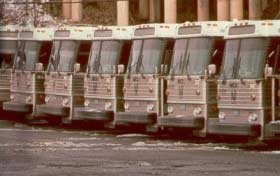 In
city after city, transit agencies are discovering that bicycles and transit
are agood combination. The popularity of linking bicycles with transit is demonstrated in Phoenix, for example, where a 1997 study found that there are more than 2,100
daily users of bike-on-bus racks.
In
city after city, transit agencies are discovering that bicycles and transit
are agood combination. The popularity of linking bicycles with transit is demonstrated in Phoenix, for example, where a 1997 study found that there are more than 2,100
daily users of bike-on-bus racks.
In Aspen, Colorado, bus operators must often turn away bicyclists in the summer mountain biking season; in Austin, Texas, and Seattle, Washington, transit agencies recently decided to equip their entire fleet of city buses with bike racks. And on the West Coast, a manufacturer of bus racks for bicycles reports sales in 80 transit agencies in more than 30 States. (National Bicycle and Pedestrian Clearinghouse Technical Assistance Series, No. 1, 1995)
while U.S. transit authorities have expended considerable planning and engineering efforts to meet pedestrian needs in the interiors of transit stations, in many cases, little attention has been devoted to either the pedestrian or bicycling environment to and from stations. Poorly developed inter-jurisdictional and interagency cooperation often impedes consideration of the door-to-door experience of using public transportation. It is not unusual for several different agencies to maintain independent control over the various facilities that are used by someone walking or cycling to and from a single transit stop.
|
Unless these agencies agree to cooperate together in assessing, planning, and enhancing non-motorized transit access, major impediments to pedestrian and bicycle access may persist or grow in severity. Local and State governments with the authority to manage, maintain, and construct pedestrian and bicycle facilities and roads should cooperate with transit agencies and interested citizens in developing action programs to reduce barriers to bicycle and pedestrian access to transit.
METRO of Seattle, Washington, for example, is working to integrate non-motorized access to transit from the beginning in plans for new regional transit services, rather than as an "add-on" to already designed transit projects. In December 1991, METRO published a Non-Motorized Access Study, which was a study conducted to assess the potential of and make recommendations for incorporating bicycle and pedestrian access into the system plan for Seattle's Regional Transit Project. The Regional Transit Project examines two future rapid-transit alternatives for the region - a transitway alternative (bus and high-occupancy vehicle (HOV) facilities) and a rail system alternative (light rail). The study notes:
"The potential commuter travel shed surrounding a transit line can be increased by adding station and vehicle amenities to allow easier interface between bicycles and the transit system."
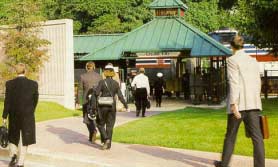 According to 1990 NPTS data, 53 percent of all people nationwide live less than 2 miles from the closest public transportation route. |
||
| Among the study's key findings are the following: | ||
| • | Approximately 1 million people live within a 2-mile (desirable biking distance) radius of the proposed rapid-transit system stations (a significant potential transit market). | |
| • | Agencies that have made improvements for bicycle access to stations see substantial increases in bicycle ridership at those stations. | |
| • | Transit vehicle (bus and rail) modifications and facility access requirements can be accommodated at relatively modest capital costs. (FHWA-PD-93-012, The National Bicycling and Walking Case Study No. 9: Linking Bicycle/Pedestrian Facilities With Transit, 1992) | |
Walking is the most environmentally friendly and low-cost way to get people to and from public transportation. When given sidewalks or trafficcalmed streets to walk along, safe and convenient ways to cross streets, and a comfortable and attractive environment, most people are willing to walk farther to reach public transportation. In the United States, however lack of attention to pedestrian needs beyond the bounds of the transit station seems fairly common. The location of parkand- ride lots is often not amenable to non-motorized access. One transit agency commented that all of their park-and-ride lots are located near freeways and/or shopping areas where residential housing is quite far away and there are no paths or sidewalks located near the park-and-ride lots.
Some U.S. transit and transportation agencies, however, are showing a growing and promising awareness of the need to focus on the larger environment that surrounds and leads to transit stations and bus stops:
The Southern California Rapid Transit District (SCRTD) has developed an interactive computer demonstration of the sidewalk "level of service" effects of pedestrian overcrowding. This was used in a successful effort to mitigate a plan by the Los Angeles Department of Transportation to take sidewalk space away from a rail station area that will serve the intersection of the RED and BLUE rail transit lines. SCRTD has also completed a plan to improve pedestrian access to the Hill Street Metro portals, including wider sidewalks, pedestrian shortcuts to key destinations, trees, and a pedestrian walkway connecting the Museum of Contemporary Art with the newly installed "Angel's Flight" cable railway.
METRO of Houston recently entered into a program to implement sidewalks along major roads to provide access to their transit facilities.
All-light rail transit (LRT) stations in Sacramento, CA, except one which is located in a freeway right-of-way, provide at-grade pedestrian and bicycle access. Some 17 of the system's 28 stations are within three blocks of a city or county trail facility. Linkages at most stations are via residential or connector streets with low traffic volumes, presenting fewer problems for people on foot or bicycle. Four LRT stations are located on pedestrian/transit malls.
Portland offers an outstanding example of linking pedestrian facilities to public transportation. Reallocating street space downtown to transit and pedestrians has helped keep the central business district healthy, retaining a much higher share of regional retail activity than in other cities where downtown area has declined. (NBWS Case Study No. 9)
A variety of facilities and services are being provided: bike racks on buses; provisions for the transport of bicycles on light- and heavy-rail transit, commuter rail, and long-distance trains; bike parking at transit stations; design improvements at transit stations (curb cuts, signing, and lighting); links to transit centers (bike lanes, multi-use trails, and widened roadway shoulders); and bicycle-ferry programs.
A thorough discussion of the issues surrounding the implementation of bicycle-transit integration is found in two documents: Linking Bicycle and Pedestrian Facilities With Transit, National Bicycling and Walking Study, Case Study 9; and Integration of Bicycles and Transit, Transportation Research Board (TRB), 1994.
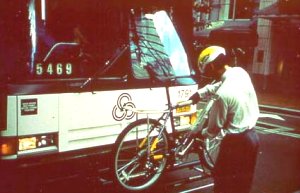
The preferred style of bike rack mounts to the front of the bus.
Bike-on-bus programs are functionally similar to bike-on- rail programs, but often operate in much lower density corridors than rail transport. By expanding a bus line's access and egress service area, bike-onbus programs can attract many passengers who would not otherwise be able to use transit for their trip, particularly to reach suburban destinations where transit coverage is often sparse.
There are three means of accommodating bicycles on buses – rear-mounted racks, front-mounted racks, and allowing bikes inside the bus. Rear-mounted racks were the earliest type of systems, but preferences appear to have shifted toward frontmounted racks. At least three transit systems now use rear-mounted racks – San Diego Transit, Humboldt Transit Authority in northern California, and the Santa Cruz Transit District in California. Two agencies that previously used rear-mounted racks- North County Transit in northern San Diego County and Windham Regional Transit in Willimantic, CT- have changed their policies; the former to front-mounted racks and the latter to a policy that permits bikes inside the buses.
Most U.S. bike-on-bus services do not require a permit, in contrast to most U.S. bike-onrail services. While most U.S. transit systems accommodate bikes only on designated routes, a few cities, such as Phoenix, AZ, Aspen, CO, and Sacramento, CA, have no route restrictions and have opened their entire system to carrying bicycles.
|
The City of Phoenix began a 6- month bike-on-bus demonstration program from March through August 1991 to assess potential use of the service. Bicycle racks were mounted on the front of buses operating on three routes that were selected based on criteria developed in coordination with the bicycle community. Two-thirds of the $15,000 program cost came from a grant by the Arizona Department of Environmental Quality. During the demonstration program, 5,500 bicycle trips were taken and ridership steadily increased. At the end of the first month, 153 riders had used the service. By the end of the third month (May), this jumped to 1,109 riders per month and by the end of the 6 months, there were 1,404 riders per month. Phoenix Transit reported no safety problems associated with the new service. The service not only attracted increasing numbers of bicyclists, but also attracted to transit people who did not previously use buses. A Bike Rider Survey found that the vast majority (90 percent) of the bus riders used the bike racks for commuting. An evaluation of the demonstration concluded:
"From the response received, it would not be a stretch to say that the program was overwhelmingly popular among transit riders and [was] hailed as an excellent idea by bike riders. For bus patrons it is an added option, for bike riders it is an opportunity, and for public transit it is another step toward reducing the number of vehicles traveling on the road."
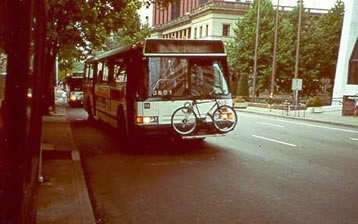 As
a result of the successful demonstration, the Phoenix Transit bike-on-bus program
was expanded system-wide in July 1992. By 1997, all 463 buses in the Phoenix
system were equipped with front-mounted bike racks, each of which carried two
bikes. A survey in 1997 found that there were 2,146 daily users of the bike
racks within Phoenix alone (not including use outside of Phoenix).
As
a result of the successful demonstration, the Phoenix Transit bike-on-bus program
was expanded system-wide in July 1992. By 1997, all 463 buses in the Phoenix
system were equipped with front-mounted bike racks, each of which carried two
bikes. A survey in 1997 found that there were 2,146 daily users of the bike
racks within Phoenix alone (not including use outside of Phoenix).
Although most transit agencies offering bike-on-bus services have relied on various devices outside the bus, a few agencies have decided that added hardware is unnecessary and have allowed bicycles inside their buses. Westchester County Department of Transportation (WCDOT), located near New York City, simply adopted a permissive "welcome aboard" policy toward bicyclists and other potential users beginning in the late 1970s. The space provided for wheelchair-bound passengers could be used by those traveling with baby carriages, shopping carts, bulky packages, or bicycles. This policy applied only to handicapped-accessible Advanced Design Buses and only in non-peak periods. Wheelchair users were given priority over bicycles at all times. No problems had been reported with the service.
9.7 Bike-on-Rail Programs
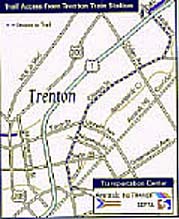 Connections between transit systems and bike networks and pedestrian trails make it obvious how convenient these options of travel are. |
The first American commuter rail system permitting bicycles in passenger coaches in recent years was the Southern Pacific Railroad (SP), serving San Francisco and San Jose. A 4-month demonstration project in 1982, sponsored by the California Department of Transportation (Caltrans), allowed cyclists to secure their bicycles in the aisles of the rail cars at no charge during non-peak hours. No permit was required. Southern Pacific's management, however, showed little enthusiasm for the project and demanded payment of $73,000 by Caltrans to indemnify SP for potential accidents. While there were no schedule delays, injuries, or inconveniences to other passengers during the 4-month demonstration, lack of publicity and a short program duration resulted in low bicycle use-only about 100 users per week. SP management's demand for costly insurance payments – more than $100 per bicycle trip – resulted in the program being dropped.
At the time of the Caltrans demonstration project, only two other North American rail systems had carried bicycles for more than 1 year: BART, the rail rapid transit system in the San Francisco Bay Area and Port Authority Trans-Hudson (PATH) in New Jersey, which started its bike-on-rail program in 1962.
BART's program enjoyed strong public support; by 1980, BART had issued more than 9,000 bike-on-rail permits. Community support and the excellent safety record of the program prompted BART to relax restrictions on the bike-on-rail service and permits were made available through the mail. By 1984, the number of permits had more than tripled to 28,000; this had grown to 71,000 permits by 1992. BART's success prompted other rail systems to institute bike-on-rail programs. Today, they exist on many commuter rail, and heavy and light rail transit (LRT)systems in cities across the country, and other transit agencies are planning bike-on-rail service.
New light rail systems that have opened in some U.S. cities in recent years are integrating bicycles with their systems, providing bicycle parking at stations, and permitting bike-on-rail service. These include LRT systems in Santa Clara County, San Diego, Sacramento, and Los Angeles, CA and Portland, OR. In mid-1992, Portland initiated a more comprehensive bike-on-transit program, including bikes on the LRT and on regional buses, and increased bicycle parking facilities at stations.
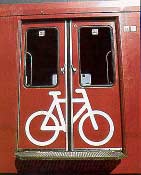 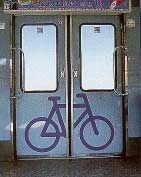 Bicycle stencils on outside and inside doors of Danish State Railways, local "S-Tog" trains indicate those doors where bikes may be brought on board the train. |
Most U.S. transit authorities with bike-on-rail service require a bicyclist to obtain a valid permit. Costs for the permit generally range from $3 to 5 and are valid for varying lengths of time. Some systems, especially those with newer programs, require annual permit renewal, while on other systems, permits may be valid for 3 to 5 years, and on some, for an unlimited period. While the permit process provides a means of assessing use of the system and ensures that bicyclists are familiar with the program rules and regulations, permits severely constrain demand, generally excluding tourists and potential occasional users. A few simple billboards or signs in transit vehicles and near stations, as found in Europe, would provide an alternative means of communicating rules of operation.
It is notable that not a single European bike-on-rail program requires a permit for the carriage of bicycles. A large number of rail systems across Europe allow bicycles on trains. Some offer this service for free, while others charge a fare supplement for the bicycle. Eliminating permits allows them to attract a larger pool of users, generate added revenues, and avoid the often considerable costs associated with permit administration. Santa Clara County Transit, in California, is the first U.S. transit agency to take a more European attitude toward the bicycle, allowing them on board without a permit, at no extra charge.
The U.S. bike-on-rail services are almost all restricted to times outside the weekday peak hours. The exceptions are BART in San Francisco and the commuter rail system in Boston, MA, which allows bicycles to be carried during peak hours in the "reverse commute" direction only. Restrictions on most systems prohibit bicycles on rail weekdays before 9:00 a.m. or 9:30 a.m. in the morning (some allow bikes before 6:00 a.m.) and from 3:00 p.m. or from 3:30 to 6:30 p.m. Weekend policies vary, with some systems having no restrictions and some blocking out certain hours when there is substantial shopping, work, or recreational travel. Several European bike-on-rail systems, including Oslo and Amsterdam, have no time restrictions on the time when bicycles can be brought on board. Without any restrictions, bicyclists, using their own common sense, tend to naturally avoid bringing bicycles into rail cars during crowded rush hours. Santa Clara County Transit again leads the United States in adopting the most European attitude toward bike-onrail, allowing two bicycles per car in peak hours, and four per car in non-peak hours.
Restrictions on the number of bikes permitted on each rail transit system vary. Some systems permit two bicycles/car and others allow bicycles only on the last car of the train, with a maximum of four bicycles/train. In Santa Clara County, the bike-on-rail program is so popular that the number of bikes far exceeds the limit. Passengers are expressing concerns about access problems caused by bicycle overcrowding and efforts are under way to try to resolve this.
Rail transit system restrictions on the number of bicycles permitted are based in part on rail car designs in this country, in which bicycle accommodation has not been a consideration. On the MARTA system in Atlanta, and on other systems, bicyclists hold their bikes in a fold-up seat area near the backdoor of the rail car.
In California, design of the new "California Car," mandated and funded by Proposition 116, requires accommodation of a reasonable number of bicycles carried on board by passengers for both inter-city and commuter applications. The California Car is a bi-level car that superficially resembles Amtrak's Superliner, but with significant design differences, including bicycle storage on the lower level of the car. The new rail car, which will be used on Statesponsored Amtrak and local commuter rail services, is a promising new development in the United States. Its specifications could be adapted by other rail agencies to enhance bicycle-rail linkage.
Cities and transit authorities across the country are beginning to recognize the crucial role of secure bicycle parking at transit stations in promoting increased bicycle access to transit. A number of the Nation's commuter rail and rail transit systems are investing in bicycle parking, but many lack a more comprehensive strategy that looks at the environment beyond the station. Frequently, the quality of the parking provided is inadequate, leaving most bicycles vulnerable to theft and vandalism. The majority of suburban bus transit systems, which could expand service area and ridership through bicycle-transit interface, appear to pay little, if any, attention to bicycle parking facilities at bus stops.
There is wide variation in the use of bicycle racks and lockers between rail stations and also between transit systems. A crucial factor appears to be the degree to which the environment leading to the station is bicycle-friendly and the quality of the bicycle parking provided. In areas where separate bicycle paths or bike lanes on streets have been implemented, facilitating connection to rail or bus services, the ease and safety of access by bicycle is greatly enhanced. Access to many stations is on streets where little or no thought has been given to bicycle safety, curtailing the extent of bicycle access. The degree to which a transit agency actively promotes its bicycle parking facilities, and more broadly, promotes the environmental and social benefits of bicycle access vs. auto access, also impacts upon the use of bicycle lockers and racks.
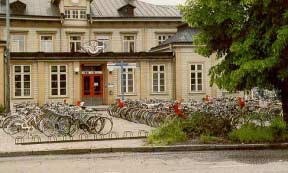 As in Vasteras, Sweden, cycle parking in the downtown area is essential to the encouragement of cycle commuting as well as leisure travel to the city's center. |
The Economics of a Guarded Bicycle Parking Garage in Germany
Since July 1989, in Wunstorf, Germany, near Hannover, local authorities, working
with a private bicycle shop owner, have developed a "Bicycle Station"
to provide 320 guarded bicycle parking spaces at the railway station, along
with bicycle rental and repair services. In the first 22 months of operation,
the number of bicycles parked at the rail station increased fourfold to about
160 each day, with growth continuing at a rate of 20 to 30 percent per year.
Since the second year of operation, some 60 to 90 bicycles were rented each
month in the warmer months of the year, mostly on weekends.
The facility and rental bicycles are in public ownership, but operations are handled under a private franchise contract. User fees for parking have been set at US$1.85 per week, $5.60 per month, or $56 per year for those with a weekly, monthly, or yearly railway pass, respectively; without a railway pass, parking fees are one-third higher. Single-use parking costs US$0.75 per day. The vast majority of users buy monthly parking cards to obtain the discount they offer.
Bicycle parking fees comprise twothirds to three-fourths of the revenues in any given month, with bicycle repair work comprising most of the remainder, except in the warmer months, when bicycle rentals, mostly for recreational use, provide up to a fifth of revenues. The franchise operator is guaranteed minimum receipts by the local authorities of US$750 per month, but as of May 1991, monthly revenues from the operation were US$1,650 and were continuing to increase at a steady pace, so this guarantee was not being exercised.
Total cost of the operation is about US$8,900 per month. The government provides a fixed subsidy of about US$7,100 per month (or about US$22 per bicycle parking space) and the franchise operator pays the remaining costs of about US$1,800. The franchise operator is responsible for the cost of providing a bicycle mechanic, insurance, and maintenance of rental bicycles, and a portion of utilities and building insurance, while the government supports other costs as a means of encouraging the use of transit and bicycles. With a continuation of the fixed contract subsidy, the franchise operator was anticipated to achieve profitability in his activities at the Bicycle Station by the end of 1991.
The Bicycle Station is open 108.5 hours per week and is staffed by three people over the course of a typical day. Labor costs comprise 83 percent of the costs of operation. A study that examined the possibility of semi-automating the bicycle parking garage using a system found in Japan and the Netherlands estimated that the full cost of conversion would be about US$121,000 to provide a 168-bicycle capacity system, or $720 per unit capacity.
The success of a bicycle-transit integration program may hinge on the quality of bicycle access to and from the transit facility. Multi-use trails, rail-trails, on-road bike lanes, widened shoulders, and sidewalks often provide critical transportation linkages from neighborhoods and business or commercial districts to transit centers. Trails that parallel rail corridors, or rails-with-trails, offer another way to link the two modes. (NBWS Case Study No. 9)
Integration enhances travel potential for both modes of travel by offering a number of advantages that each mode alone cannot provide:
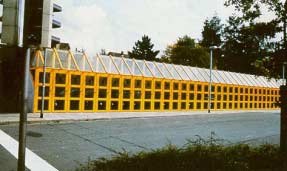 Bicycle shelters used in Germany allow a bike to be parked for 4 days before being moved to a long-term parking area, allowing commuters to leave bikes over the weekend. |
Integration lowers air pollutant emissions from trips taken on public transit. Outside of central business districts, most commuters using rail transit and park-n-ride lots arrive by auto; and typical trip lengths are 3 to 6 km (5 to 10 miles). For an auto trip of 11 km (7 miles), nearly 90 percent of the emissions occur in the first 1.6 km (1 mile), known as the "coldstart" stage.
In most situations, encouraging auto commuters to drive to rail or bus transit produces little air quality improvements. However, converting transit access trips from auto to bike, or converting car commutes to bike-n-ride transit trips, can produce significant emission reductions. (FHWA-PD-93-012, 1993)
Integration reduces the cost of constructing automobile park-n-ride lots, which vary from $1,500 to $20,000 per space. The cost of providing bicycle parking and storage facilities averages $50 to $500 each.
In rural communities, integration offers touring bicyclists and other tourists auto-free access to popular recreation destinations such as trails and parks and provides rural bicycle commuters the means for inter-city or inter-town commuting. (FHWA-PD-93-012, 1993)
Many successful programs began with a limited demonstration phase, then expanded to a broader, or even system-wide, operation. Demonstration projects tend to focus on identifying and solving specific technical and operational aspects of the service, and usually lead to wider program implementation.
This committee should include nonagency organizations and individuals who have experience in bicycle advocacy in their community, an interest in bicycle-transit programs, knowledge of user needs and constituency characteristics, and some expertise in bicycle and/or transit issues.
A bike-transit program must vigorously market and promote in order to be effective: a brochure describing the agency's program, a telephone number for information, and drawings or photographs of equipment to help users understand operating procedures. The Tri-Met in Portland, Oregon, distributed 4,000 brochures directly to the local bicycle advocacy group's membership. In Philadelphia, the Southeastern Pennsylvania Transit Authority (SEPTA) prepared a pamphlet highlighting eight scenic and cultural destinations for bicycle touring that were accessible by its local rail systems. Biketo- Work Days and bicycle fairs, or offers of free test rides, have also proven to be effective in promoting new programs.
The Rails-To-Trails Conservancy has documented the use of Intermodal Surface Transportation Efficiency Act (ISTEA) funds in the development of dozens of bicycle-transit integration facilities. ISTEA/TEA-21 programs being used include the Congestion Mitigation and Air Quality Improvement Program, Surface Transportation Program, and the Transportation Enhancements Program. Through the Federal Transit Program in TEA-21, several funding sources are available for bicycle and pedestrian access improvements.
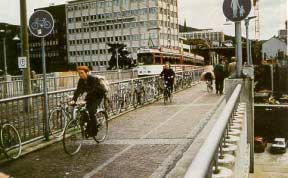 A pedestrian and bicycle bridge near the Freiburg rail station carries thousands of people each day. |
Choose a local transit station (or individual transit stop) and determine the potential catchment area. Design a program for increasing bicycle and pedes- trian access to the transit station, including both design improvements and education/promotion efforts. For physical improvements, include both the immediate vicinity, as well as connections to origins that lie in the catchment area.
Choose a nearby transit stop or park-n-ride station and ride a bike or walk to it. Document the problems along the way, as well as those you experience when you arrive at the station/stop. Given your knowledge of the community, what would it take to get people to bicycle and walk to this site?
For an analysis of the state of the practice, see Integration of Bicycles and Transit. Write: TRB, National Research Council, 2101 Constitution Ave., NW, Washington, DC 20418, $12.
The FHWA reports listed below are available through the FHWA Report Center, 9701 Philadelphia Court, Unit Q, Lanham, MD, 20706. Telephone: (301) 577- 0818, Fax: (301) 577-1421.
Federal Highway Administration, National Bicycle and Pedestrian Clearinghouse Technical Assistance Series, No. 1, 1995. Federal Highway Administration, National Bicycling and Walking Study-Case Study No. 9: Linking Bicycle/Pedestrian Facilities With Transit, FHWAPD- 93-012, 1993.
Federal Highway Administration, National Bicycling and Walking Study – Case Study No. 17: Bicycle and Pedestrian Policies and Programs in Asia, Australia, and New Zealand, FHWA-PD-93-016, 1993.
To learn more about successful bicycle-transit integration services, contact the following:
| < Previous | Table of Content | Next > |
